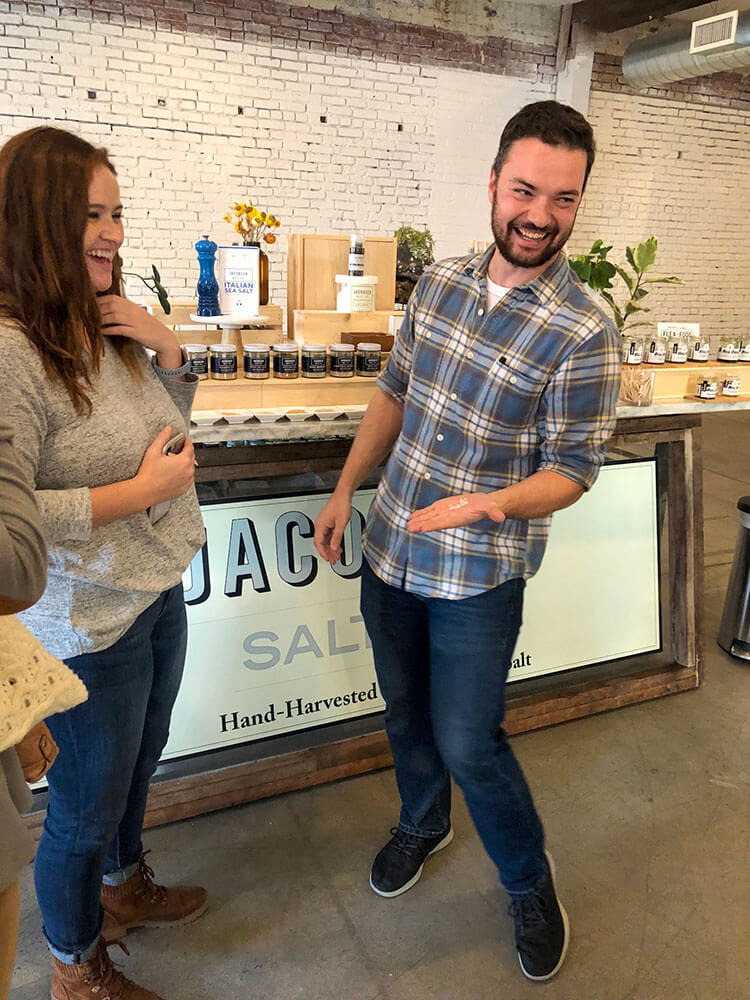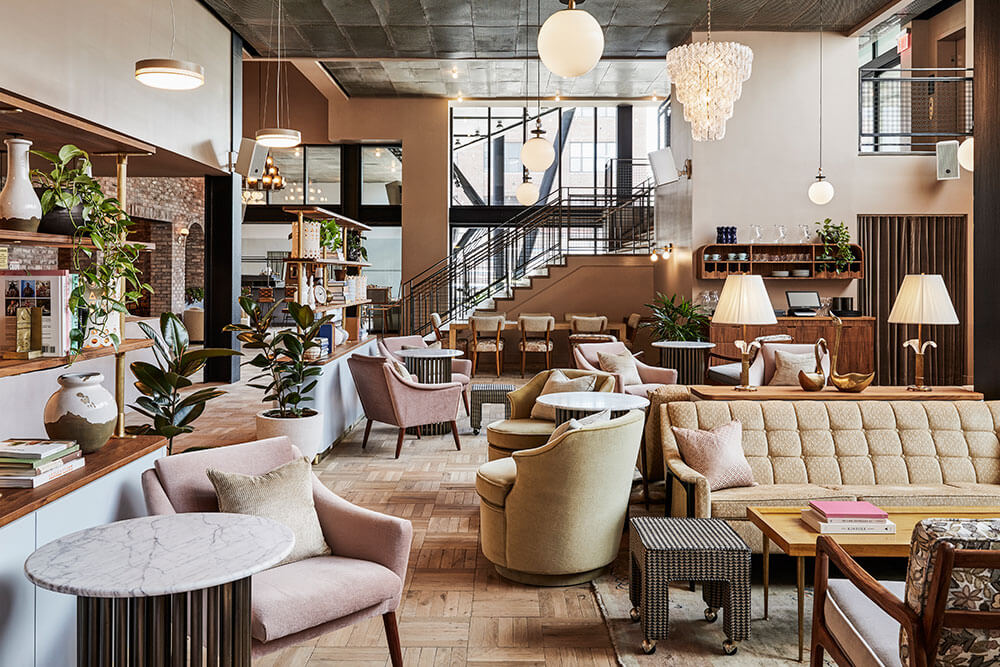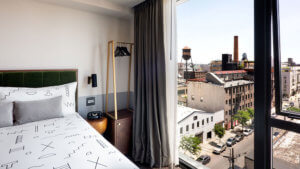
Bollywood Theater PDX in southeast Portland is a favorite with residents. (Travel Portland)
Portland resident Laura Morgan has a passionate interest in food, along with architecture, culture, history, and the stories of the people who live in her city. At her tour company, Big Foody PDX, which she founded in 2016, Morgan organizes truffle-foraging expeditions at a forested Willamette Valley vineyard and walking tours through neighborhoods in east Portland that include conversations with the artisanal food producers who have helped put the city on the culinary map. Her inspiration, Morgan said, was to provide “a deeper dive into the food and drink culture of the place for the people who are looking for it.”
What she hadn’t expected, she told Convene, was that so many of the people looking for that kind of connection to the city and its surroundings would be business travelers. The appetite for experiential tours among those who come to Portland for meetings and conventions has grown noticeably in the last two years, Morgan said. So much so, that she predicts that the days when business travelers see only see the inside of their hotels, moving from conference room to hotel room and back again, will soon be history. “We’re starting to see whole groups coming to Portland who want to experience the city in new ways,” she said, “ways that are more genuinely satisfying and exciting.”

Amy Blackman (left) and Kate Fairweather
Morgan’s observations are mirrored in the insights from “The Future of Meetings and Events” report, a joint research project between Marriott and the PCMA Foundation, which identified five major, future-oriented consumer trends and market forces that will be transforming meetings and events in the years to come.
One trend in particular, “a sense of place,” speaks directly to enterprises like Morgan’s food tours, recognizing that immersing meeting participants in the local landscape and connecting them with local culture and community leads to more memorable events.
“This won’t be news to anyone, but millennials don’t really care about material things,” said Amy Blackman, a strategy consultant for Fruition in Los Angeles, at a Convening Leaders 2019 session in Pittsburgh last month, where the research was released. According to Mintel, a global market research firm, 85 percent of millennials identified venturing out of their comfort zone and learning new things as among the experiences they value most.
Consumers “don’t want sterile corporate environments,” added Kate Fairweather, who co-presented the session with Blackman. Fairweather is an innovation consultant for Fahrenheit 212, the New York City–based global consultancy firm that created the report, and Blackman was one of the study’s thought-leader contributors. “They’re looking for location-true, authentic, off-the-beaten-path, things-I’ve-never-seen-before places,” Fairweather said. “They want to be immersed in culture and they want to explore.”

A Big Foody PDX visit to the tasting room at Jacobsen Salt Co. in Portland, a company that hand-harvests sea salt on the Oregon coast.
Morgan taps into that desire in her tour business. “When people come to Portland, many arrive with the expectation that they are going to eat and drink well, because our reputation has preceded us around the world,” Morgan said.
Along with locally produced chocolate and artisanal charcuterie, honey, and beer, Morgan’s tours introduce people to local history and culture.
“One way to genuinely experience this place is by connecting travelers with the human beings behind the products,” she said. “Successful food-and-drink businesses are created by passionate, and oftentimes big, personalities, and they are run by hard-working people who believe in the mission. Most of them are people who also care deeply about our community and want to share the love.”
Morgan plans her tours using some of the same skills and insights that event designers employ — her events just happen to be mobile. “When I’m putting together a new experience, or improving on one that already exists, I’m always trying to think about where the ‘aha’ moment occurs,” she said, “and then, how to inject surprise and delight at the right points throughout.”
Her aim is to help people get behind the scenes in Portland and the surrounding area, in ways that encourage them to use their senses, she said. “I’m also thinking about the experience as a whole and if it delivers the message that I’m trying to get out there. The message might change for different types of tours.
“As we’re walking through the Central Eastside, a historically industrial, still-gritty part of town, people can easily see Old Portland, but also how it is changing in positive ways,” she said. “For example, they might find out that a 100-year-old Japanese bakery closed a few years back, but that a new Japanese deli has opened up inside a home goods store with the mission to bring Japanese home cooking into American kitchens. They might see what were rundown buildings finding new life as pop-up dinner spaces or music venues or art galleries.
“At each stop, I’m also talking about the spirit of collaboration,” Morgan said. “We talk about ‘community not competition’ a lot here. This comes from a tradition of strong community ties in a town that people don’t move to for high-powered corporate jobs, but great quality of life, easy access to nature — and beer.”
Morgan partners with local women-run businesses to combine an afternoon of dog-led truffle hunting amid stands of Douglas firs with a four-course dinner with wine pairings.
“I think the most underestimated part of the trip,” Morgan said, “is the opportunity to simply be in the forest as the rain falls on the tree canopy, moving our limbs and putting our hands in the earth.”
In Japan, Shinrin-yoku, or “forest bathing,” “is the therapeutic act of just spending time in the forest,” Morgan said. “Keeping in mind we’re asking people to spend time out in the cold, getting wet, possibly muddy,” she added, “balancing that with a warm and satisfying meal at the end in which we get to gorge ourselves on our haul seems like sensory magic.”

The Gather Greene event venue and nature retreat in upstate New York is intended to blur the boundaries of indoor and outdoor spaces.
No, Don’t Give Them the Generic
Greg Fuson, a Sacramento, California–based event designer, also uses local experiences and venues to create a sense of place at his events. There are so many alternatives now available to people, he said, that “large, bland, generic, all-things-to-all people events are losing their appeal.” It’s the “smaller, very targeted, very niche-oriented experiences that are rising up,” he said. “That’s where people are finding their community.”
Fuson was formerly vice president of content development for PCBC, the Pacific Coast Builders Conference, where he founded The Vine, a smaller, PCBC-sponsored conference dedicated to exploring the nature of community. In 2019, Fuson will produce the second iteration of Matter, a 100-person conference centered on creative placemaking.
“What creating a sense of place does not mean,” Fuson said, “is that you’re holding your convention in Las Vegas and so you have an Elvis look-alike opening party.” When Matter takes place next month in Los Angeles, he said, there deliberately won’t be a “Welcome to Hollywood” glitz-and-glamour reception.
The character of the environment matters a great deal to attendees who come to the conference from a wide range of industries that are concentrated around community development, neighborhood planning and design, and placemaking, he said. “They are very keyed into place and surroundings.”
Creating a sense of place works best, Fuson said, “when the thing that you are tying into is attached to an authentic story.” For Matter, Fuson selected a 114-year-old venue that was originally built as a chapel and served as the hub of a residential neighborhood for many years, as well as a meeting place for both the women’s suffrage and civil rights movements.
“What I tell every single speaker is that it’s a small venue and will be filled with people who are really heartfelt and passionate about the work that they do, and they want to hear those same things from you,” Fuson said. “I try to set the whole thing up like it’s a living-room conversation and not like they’re standing in a ballroom delivering a lecture.”
One of his goals, Fuson said, is to make people cry. “When you feel something emotionally, you’re much more receptive to change,” he said. “The second thing I want is for people to change something as a result of what they felt, whether that’s in their personal lives or the way that they approach their job or the way that they treat their coworkers,” he said. “I want what they feel to translate into change and then I want people to share the experience with others.”
Over the course of the two-day conference, Fuson also layers in performance art, music, and video. “I’m trying to hit on a lot of different senses, so that at no point along the way, do you feel like it’s getting stale.” A big part of the experience, he said, is that participants don’t feel like they are in a big, boxy hotel — instead, “you feel like you’re in the middle of a charming neighborhood.”

Durham, North Carolina’s American Tobacco Campus, formerly the Lucky Strike cigarette factory, is now home to startups, university offices, and event space. (American Tobacco Campus)
A Sense of Workplace
As a participant in the future trends study, Blackman was “very vocal” about the need for event designers to do what Fuson is doing — getting people out of hotels and convention centers into alternative spaces where they can immerse themselves in local culture, she told Convene in a phone interview.
Including the local work culture: When Blackman spoke at the Thrival festival in Pittsburgh last fall, she, along with other participants, spent part of her time working with staff at Google’s Pittsburgh offices, housed in a 100-year-old building that was once a Nabisco cookie factory.
Repurposing old manufacturing spaces is a trend in cities like Pittsburgh, where the industrial past is being reinvented into a knowledge economy, and in New York and San Francisco, which “are just running out of new real estate,” Blackman said. “There is a certain appeal about buildings with character and historic places that have cultural meaning and value in the city,” she said. “There are a lot of studies about how those types of spaces spark more creativity and innovation than glass office buildings.” And for business events focused on innovation, “if you want to immerse participants in a startup culture, that means you have to go to where startups are,” she said.
In Durham, North Carolina, that includes the one million-square-foot American Tobacco Campus, a cluster of red-brick buildings that once held the Lucky Strike cigarette factory. It is now home to many of the entrepreneurs who helped earn the city a ranking in the top 10 cities for tech professionals in a 2017 Forbes survey. In addition to office and laboratory space, the American Tobacco Campus is home to restaurants, coffee shops, and venues used for events including Moogfest, a music and technology festival that stages a synthesizer demo lab in the former power plant of the century-old factory.
The four-year-old Idea Foundry, in Columbus, Ohio, also was established in a century-old building that once was a factory — in this case, a shoe factory. The space, in the Franklinton neighborhood, just east of downtown Columbus, kept its industrial feel, with exposed brick, pipework, concrete, and “beautiful wooden floors, which are well worn and well loved,” said Karla Ross, CTA, the events coordinator of the space. “It’s just the right mix of the future and the past.”
The building’s 60,000 square feet hold more than 220 small businesses and labs, a co-working space, and event space, Ross said. The Idea Foundry is one of the world’s largest “Maker Spaces” — a term applied to collaborative workspaces where products are designed and fabricated — with labs devoted to everything from 3D printing to black-smithing, Ross said.
As the building’s event coordinator, Ross works with clients to design events, including tours and hands-on experiences, ranging from turning wood on a lathe to screen-printing. The Idea Foundry can accommodate large groups — up to 300 for talks and demonstrations — but the ideal group size for workshops is 100 or fewer participants, she said. “Smaller groups are going to have the most enjoyable experience. The larger the tour, the less engagement.”
The Idea Foundry team, which has traveled all over the world to talk about the Maker Movement, is available to present to groups using the space.
Idea Foundry members “are very connected with the future of the workplace,” Ross said. The whole space is infused with a spirit of entrepreneurialism and collaboration, where “one encounter,” she said, “can change your whole perspective.”

The “open-house” lobby at The Hoxton, Williamsburg, welcomes locals to camp out with their laptops.
The Local Connection
When Morgan, the founder of Big Foody PDX, travels to new destinations herself, she often asks locals where they love to eat and why, she said. “They’ll often say something like, ‘If it’s sunny outside, go to this deli, get this menu item, and take it to this spot to people watch and eat.’”
Morgan is not alone. For more than half of the respondents in a 2017 survey on emerging travel destinations, the most interesting part of travel is discovering “secret places” or hidden parts of a city that are only known to locals, according to the Marriott/PCMA Foundation future trends report.
That basic strategy — ask a local — is foundational at The Hoxton, Williamsburg, the first hotel under The Hoxton brand to open in the United States. Even before the hotel opened in Brooklyn last September, management invited 175 local residents to handpick 10 books that now sit on a shelf in each of the hotel’s 175 guest rooms. The locals also supplied the room’s future guests with tips for what to see, do, and eat in the neighborhood, written on bookmarks. The local influencers, which the hotel finds by word-of-mouth, are neighborhood business owners and artists, “not boldfaced names,” said Anna Stancioff, director of PR, North America, for the hotel.

NYC’s iconic water towers once were built on the site of The Hoxton Williamsburg.
Each of the Hoxton hotels — there are six, including the Williamsburg hotel and one in Portland — has a cultural marketing manager who organizes a rolling agenda of talks, screenings, and other events featuring local artists, organizations, and thinkers, designed to appeal to hotel guests and area residents.
Topics range from ice carving to creating botanical drawings, to yoga and meditation, and film. Last month, The Hoxton, Williamsburg offered ticketed events on issues including “The Loneliness of Motherhood,” and “Social Media and Mental Health.”
The design of the hotel’s meeting space, The Apartment, also mixes playfulness and purpose. Resembling a New York City apartment — a dream apartment, anyway — with high ceilings and large rooms furnished with local art, built around a communal kitchen and living-room space, The Apartment’s refrigerator is always stocked with complimentary beverages and snacks.
Built on the former site of the Rosenwach Tank Company factory, which makes New York City’s iconic wooden water towers, the hotel mostly flies under the radar from the street, marked only by street number and a small sign. Guests enter directly into the hotel lobby, a large and homey expanse of sofas, tables, lamps, and easy chairs, which was designed through a partnership between the hotel’s owners and the Soho House.
The space, like the Soho House, is elegant and warm, but unlike the members- only hotel, The Hoxton, Williamsburg operates on an “open-house” concept. Guests mingle with locals, who are invited to come and camp out with their laptops.
As I sat talking with Stancioff over coffee in the gentle hum of the lobby on a drizzly December day, where most of the sofas and chairs were filled, it was impossible to tell who was a guest at the hotel, and who was a local resident there to soak up some warmth from the fire, visible in the open kitchen, or from human company. And that’s exactly the way the hotel likes it.
“Everyone,” Stancioff said, whether a local or hotel guest, “is welcome here.”
Barbara Palmer is deputy editor of Convene.
More Meeting Trends
Test Time
Earn one clock hour of certification credit. Once you’ve finished reading this article, download the report at convn.org/future-meetings.
To earn certification clock hours, visit pcma.org/convene-cmp-series to answer questions about information contained in this CMP Series article and the additional material.
The Certified Meeting Professional (CMP) is a registered trademark of the Events Industry Council.
